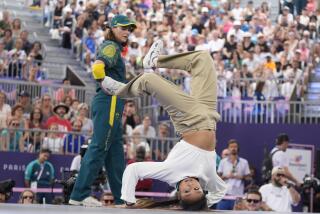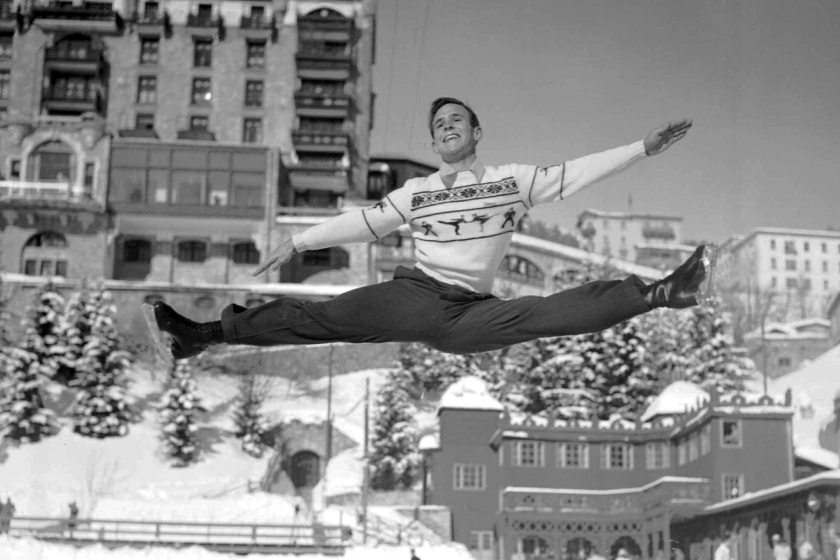The Summer of Marion Jones
- Share via
With painstaking penmanship and a few erasures to correct spellings and numbers, the little girl explained herself. The year was 1985 and she lived just east of Los Angeles. Precisely on the lines of her homework paper, arranging her thoughts in paragraphs, she wrote . . .
“Hi, my name is Marion Jones. I’m 5 feet 2 inches. I am 10 years old and in the sixth grade. I think I have a nice personality. I have pretty good grades and my weight is 85 pounds.
“My hobbies are running and gymnastics. I like running because I can beat almost everyone at my school. I like gymnastics because I can do all sort of tricks and I’m very flexible in some ways.
“My plans for the future are to be in the 1992 Olympics. I’ve been training a lot, and the boys at my school are good practice. I know if I don’t get in the Olympics, I have to have a backup. So I plan to be an electrical engineer like my uncle.”
That was then, this is now: You’ve seen the television commercial featuring her voice, soft and sexy and low-purring into a deejay’s microphone, advising the world ever so sweetly and directly to get out of her way, she’s coming through. “Can you dig it?” she says.
This is the Summer of Marion Jones. To hear her now is to be invited to pay attention not just to what she says, but to what she does. The little girl with the dream is about to leap into our hearts.
She intends to win five gold medals in the Sydney Olympics. She will win the 100 meters, 200 and long jump. She will run on the U.S. 4x100 relay team and the 4x400 team. She will do what one man and no woman--and no American man or woman--has done before--win five track and field gold medals in one Olympics. Can you dig it?
“I know the historical significance will be so great,” Jones says. She smiles. Her smile is a wonder. It has been called sweet. It has been called an assassin’s. She goes on: “When I win five gold medals, then perhaps I’ll consider it.”
Whoa, wait a sec.
Turn that volume up.
Did she say when she wins five?
Paavo Nurmi, “The Flying Finn,” won five gold track and field medals in the 1924 Olympics. Jesse Owens won four gold medals in 1936. Carl Lewis won four in 1984. If Owens isn’t the greatest Olympian ever, Lewis is. And now Marion Jones, who has never run in any Olympics, will do what Owens and Lewis didn’t? Self-confidence is one thing. Arrogance is another.
In his biography of Jones, “See How She Runs,” Ron Rapoport reports on Jones’ preparations for the 1999 world championships in Spain. She planned to compete in four events. “Coming almost exactly a year before the 2000 Olympics,” Rapoport writes, “they would be the first test of her bold, some would say foolhardy, quest to win five gold medals in Sydney.”
That meet was disastrous. Jones won the 100 but finished third in the long jump. Then, in the 200 final, muscle spasms seized her back. “I knew that if I couldn’t get my knees up,” she said, “and if the spasming didn’t stop, I was going to stop running, or I was going to take it to the ground. I was so scared.”
She fell and didn’t run again for two months. Second-guessers said she’d brought on the back spasms by doing too much; they said she should forget the long jump, which is by far her weakest event. Her answer to the criticism: She jumped more often.
“I know what I can do,” she said. She would be ready for Sydney. She missed qualifying for the ’92 Olympics at 16. In ’96 she was injured. Now is her time, and she knows it in the way prodigies know things they can’t know.
Muhammad Ali knew when he was 12 and told his mother, “I’m going to be champion of the world.” Tiger Woods, at 6 or 7, tacked above his bed a newspaper clipping of Jack Nicklaus’ accomplishments. He, too, knew. Extraordinary people, these prodigies, moving with grace and confidence denied to us bumblers.
Marion Jones knew early. She pestered her older brother, Albert, into taking her on his neighborhood sports excursions. If a girl’s presence first upset the boys, soon enough they recognized a need to compromise. “She was strong, almost as tall as most of my friends, and she never, ever quit,” Albert said.
Her election at 7 to the neighborhood’s Wiffle Ball All-Star team was “one of the most exciting moments of my short life,” Jones told Rapoport, whose biography ought to be required reading for anyone who thinks a prodigy, gifted beyond compare, just sits back and lets it happen.
Marion Jones made her life happen. She has gone from the fastest kid in her neighborhood to the fastest woman in the world. She did it in unorthodox fashion, taking time off the track to play basketball; as a 5-10 freshman point guard in 1994, she led the University of North Carolina to its only women’s NCAA basketball championship. She did it after enduring injury and innuendo (the lawyer Johnnie Cochran rescued her from false accusations of drug use).
Now she’s where she knew she would be. She knew it at age 5.
It was 1981 and she saw on television the royal wedding of Prince Charles and Diana Spencer. She asked her mother, “Why do they roll out a red carpet for them?”
Her mother said, “They roll it out for very important people.”
So the little girl then asked, “Well, when I go places, why don’t they roll it out for me?”
More to Read
Go beyond the scoreboard
Get the latest on L.A.'s teams in the daily Sports Report newsletter.
You may occasionally receive promotional content from the Los Angeles Times.






